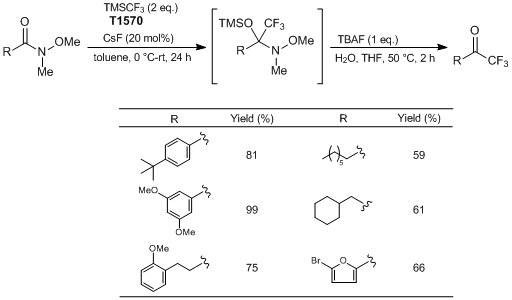Published TCIMAIL newest issue No.200
Maximum quantity allowed is 999
*Stock disponible en Belgique : Expédition le jour même
*Stock disponible au Japon : Veuillez consulter la simulation d'expédition pour une estimation des délais d'expédition (hors articles réglementés et expédition avec Carboglace)
| Numéro de produit | T1570 |
Pureté / Méthode d'analyse 
|
>97.0%(GC) |
| Formule moléculaire / poids moléculaire | C__4H__9F__3Si = 142.20 |
| Etat physique (20 ° C) | Liquid |
Condition de stockage 
|
Room Temperature (Recommended in a cool and dark place, <15°C) |
| Stocker sous gaz inerte | Store under inert gas |
| Condition à éviter | Moisture Sensitive |
| CAS RN | 81290-20-2 |
| Numéro de registre de Reaxys | 4241868 |
| Identifiant de la substance PubChem | 87577328 |
| SDBS | 19694 |
| Indice Merck (14) | 9683 |
| Numéro MDL | MFCD00145454 |
| Appearance | Colorless to Light yellow clear liquid |
| Purity(GC) | min. 97.0 % |
| Point d'ébullition | 55 °C |
| flp | -32 °C |
| Densité (20/20) | 0.96 |
| Indice de réfraction | 1.33 |
| Pictogramme |

|
| Mot de signal | Danger |
| Mentions de danger | H225 : Liquide et vapeurs très inflammables. |
| Conseils de prudence | P501 : Éliminer le contenu/récipient dans une installation d'élimination des déchets agréée. P210 : Tenir à l’écart de la chaleur, des surfaces chaudes, des étincelles, des flammes nues et de toute autre source d’inflammation. Ne pas fumer. P233 : Maintenir le récipient fermé de manière étanche. P370 + P378 : En cas d’incendie: Utiliser du sable sec, une poudre chimique ou une mousse anti-alcool pour l’extinction. P303 + P361 + P353 : EN CAS DE CONTACT AVEC LA PEAU (ou les cheveux): Enlever immédiatement tous les vêtements contaminés. Rincer la peau à l'eau. P403 + P235 : Stocker dans un endroit bien ventilé. Tenir au frais. |
| Numéro UN | UN1993 |
| Classe | 3 |
| Groupe d'emballage (DOT-AIR) | II |
| N ° SH (import / export) (TCI-E) | 2931900090 |



La FDS demandée n'est pas disponible.
Nous contacter pour plus d'informations.
Un échantillon CoA pour ce produit n'est pas disponible pour le moment.

Le tableau analytique demandé n'est pas disponible. Nous sommes désolés pour ce désagrément.